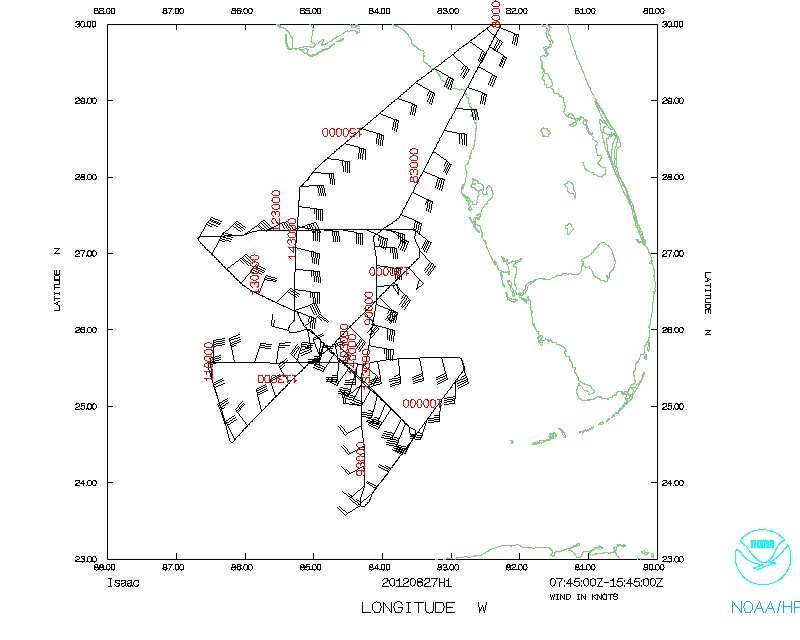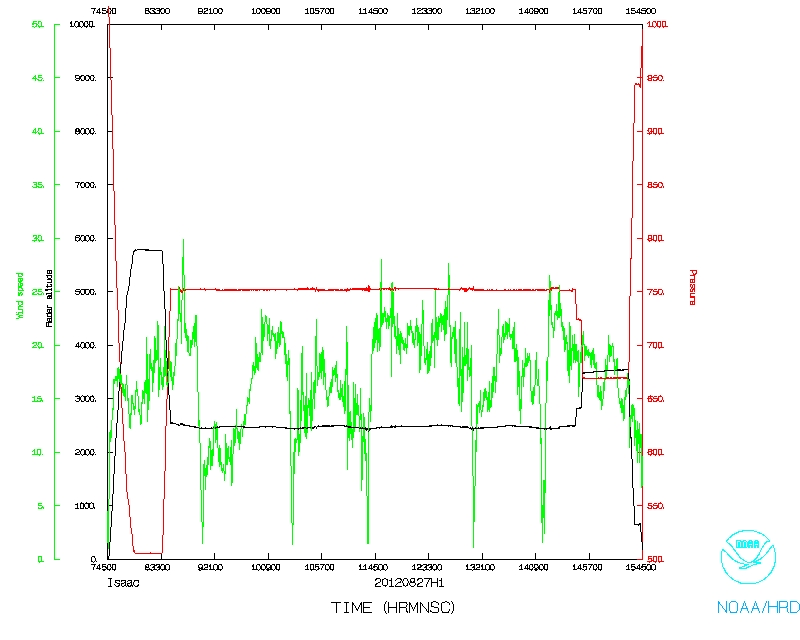Mission Summary
20120827H1 Aircraft 42RF
Tropical Storm Isaac TDR flight
Aircraft Crew (42RF)
| Aircraft Commander | Mark Nelson |
| Co-pilot | Mark Sweeny |
| Co-pilot | Chris Kerns |
| Navigator | Chris Sloan |
| Flight Engineer | Paul Darby |
| Flight Engineer | Ken Heystek |
| Flight Director | Ian Sears |
| Data Technician | Joe Bosko |
| Engineer | Charles Lynch |
| Engineer | Carlos Quiles |
| Electronics Technician | Bill Olney |
Scientific Crew (42RF)
| Lead Scientist | Frank Marks (HRD) |
| Dropsonde Scientist | Kathryn Sellwood(HRD) |
| Observer | Rob Hodges (FSU) |
| Observer | Bruce Bernstein (NBC) |
| Observer | Raul Hernandez (NBC) |
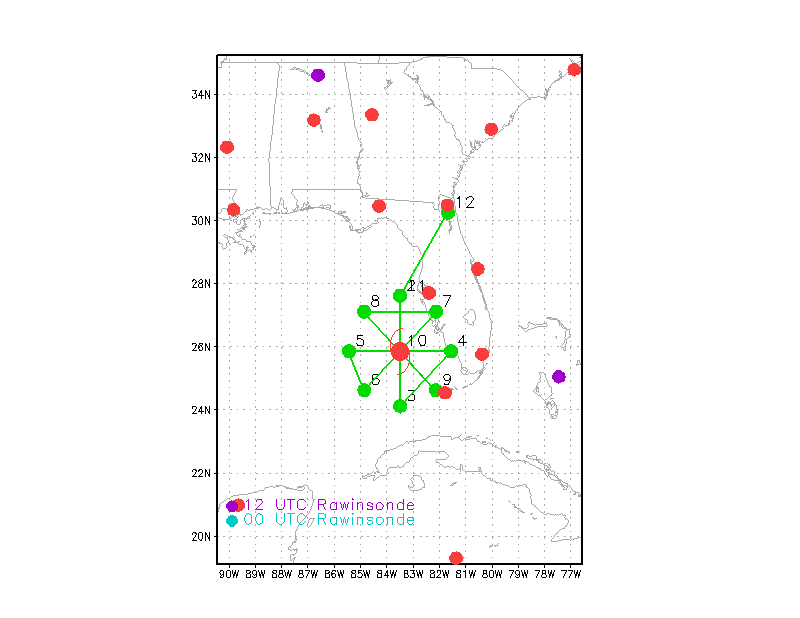
Proposed track
|
Mission Plan :
NOAA42 will fly a tail Doppler radar (TDR) mission into Tropical Storm Isaac
to gather tail Doppler data.
(http://www.aoml.noaa.gov/hrd/HFP2012/1_P3_TDR.pdf)
NOAA42 will take off from Jacksonville International at 0800 UTC and will
recover at Jacksonville International by 1600 UTC the next day. The flight
plan (see figure below) called for a rotating Figure 4 pattern with 105 nm
legs at 10,000 ft with dropsondes at the end, middle, and RMW on each leg, and
on the first and last penetration. Doppler analyses and quality control would
be done on the aircraft and for the first time we would have someone on the
ground (Mike Black) do dropsonde quality control.
Mission Summary :
| Take off
| Landing
| Jacksonville, FL | 07:45 UTC
| Jacksonville, FL | 15:46 UTC
| |
As Tropical Storm Isaac passed into the southeastern Gulf of Mexico west of
Florida (outlined in black line in top right of image) NOAA42 missions
collected airborne Doppler radar data to use in initializing and evaluating
model guidance (see flight track below). It was clear from the center drops
that the central pressure was around 989 hPa and the SFMR suggested peak
surface winds between 55 and 60 kts.
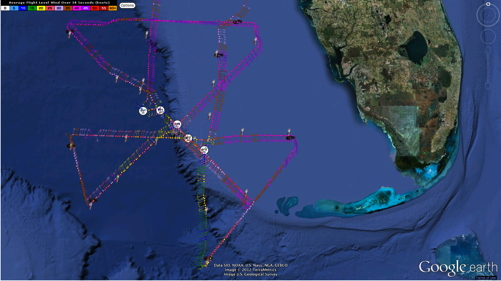
Included here you see images of the horizontal winds within the inner core of
Tropical Storm Isaac sampled from the tail Doppler radar on the NOAA42 early on
27 August 2012. These images are at three altitudes, 1 km, 3 km, and 6 km,
using a composite of winds from four legs oriented north-south, east-west,
southwest-northeast, and northwest-southeast. Also plotted on the 1-km altitude
analysis are the locations of dropsondes deployed (plotted using standard
station symbols). Isaac's circulation is much more organized than in the
previous mission, with a clear circulation center at all altitudes shown,
but still very asymmetric with the stronger winds north and east of the
circulation center. The circulation center is only slightly tilted from south
to north with increasing altitude from 1-km altitude to 6-km, much less so than
the precious mission. The observed tilt with increasing altitude suggests that
the southerly shear Isaac is embedded in is much weaker than in the previous
mission. Above 6 km the circulation center tilted 5-10 km to the north and
almost vanished above 9-km altitude, suggesting the storm has a way to go is
gaining strength.
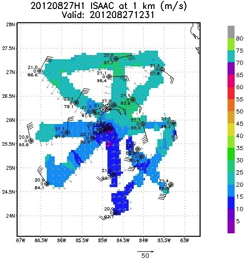

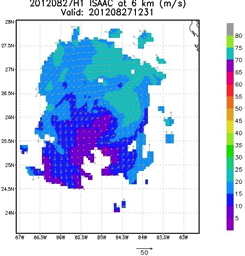
Satellite imagery (below) depicted the cloud and precipitation structure during
the missions. The top left image show the IR brightness temperatures which show
a very asymmetric high cloud distribution with the coldest cloud tops (or the
central dense overcast) to the west of the circulation center and very little
cold cloud east of the center. There were cold clouds rotating around to the
south of the center and over the state of Florida. The top right image shows
the visible cloud filed with a few tall convective turrets in the rainbands
north and east of the center along the track the aircraft entered the storm.
Other than those turrets the vast majority of the high bright clouds are to the
west and south of the center. The bottom two images are showing the condensed
precipitation, where the lower left image is the 37 GHz color image that shows
the emission signal from rain in the blue-green colors and the scattering
emission signal from large ice in the pink colors. The lower right image
depicts estimates of rain. Both images suggest that the heaviest rain was in
the bands the north and west of the center, with strong ice scattering in
convective turrets embedded in the cold cloud shield west of the center. The
rain emission signal suggests bands are wrapping around the center, but there
is no ice scattering on the east side.
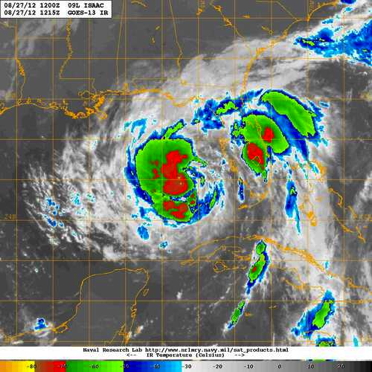


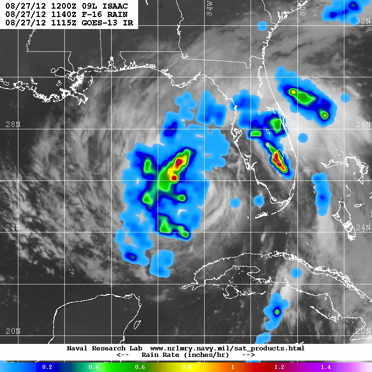
26 GPS dropsondes were deployed, processed and transmitted during the mission.
The figure below depicts the synoptic map of the surface observations from the
dropsondes.

During our mission an AFRES C-130 deployed a string of 10 drifters (5 minMet
and 5 ADOS) in across the track of Isaac to sample the upper ocean thermal and
current structure as the storm crossed the array. The figure below depicts the
location of the drifters relative to the sea-height anomaly plot. This NOAA42
missions was right over the center of the drifter string.
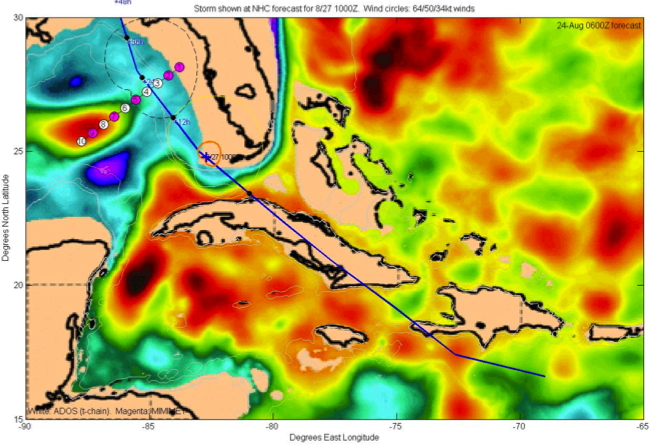
Mission Evaluation:
This was a very successful mission that met all objectives without any major
issues. 5 radar analyses, sets of superobs and radial files were completed and
transmitted to the ground. The dropsonde quality control from the ground worked
wonderfully. M. Black was able to receive all the dropsondes, quality control
them, notify us when they were completed, and we were able to grab them from
the AOML ftp site and transmit them from NOAA42.
Problems :
We had a few radar system glitches when the power cycled, once when we were
getting ready to take off and once during the mission. No significant amount
of radar data was lost during the power glitches. The WSRA was not working
during the flight and we eventually shut it off. No WSRA data was collected.
There were some issues with the HDOB wind directions transmitted on our
east-west leg suggesting that there may be a bug in AAMPS causing an 180°
ambiguity in the wind direction between north and south.
Expendables used in mission:
GPS sondes : 26
AXBTs : 0
Sonobuoys: 0
Frank D. Marks
Sept. 18, 2012
Mission Data :
Flight Director log |
LPS log |
LPS digital log |
Radar log |
Drop log |
Serial data |
1 Sec data |
NetCDF file |
Raw Fast data (NetCDF) |
SFMR (NetCDF)
Page last updated Feb. 20, 2013
Return to Mission page.











